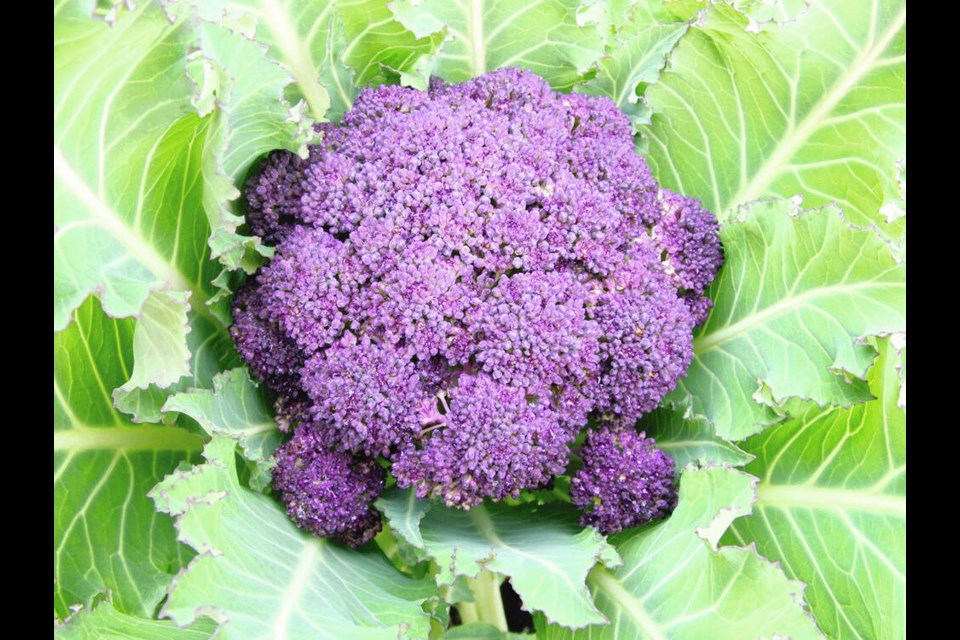Through my years of gardening, the excitement at the approach of a new growing season has never waned. This year, the season was ushered in early with a post-holiday flurry of readers’ mail, January seed purchases at local garden centres, and the first orders arriving by mail.
The parcel from Lee Valley Tools held a roll of 213-cm wide, lightweight floating row cover to secure over vegetable plantings that I know would otherwise be damaged by pests — onion fly, cabbage worms and cabbage maggot flies, leaf miner and carrot rust fly. Tucked into the package was a small, green “spot” sprinkler useful for keeping tight corners and odd spots in the garden adequately watered.
The first seeds to arrive in the mail were from Salt Spring Seeds, just a few days after I’d placed the order. Apparently I’d chosen well. A note with the seeds described all my selections as “favourites.”
Salt Spring Seeds is a source for Purple Cape overwintering cauliflower, a variety that always produces impressive heads in my garden early in the spring. This is one of the few sources for Black Forest (Kabocha) squash, which makes the best ever pumpkin pies.
Yedikule is a new [to me] romaine lettuce “grown in Turkey for over 1,500 years. Long leaves, crunchy white heart and oil-rich leaves. Great juiciness and flavour.”
I have a deep and abiding weakness for calendula and nasturtium. From the Salt Spring Seeds selection of flower seeds I chose Buttercream nasturtium, whose “softly mounding forms” and “creamy blossoms” were an “absolute knockout” in 2020 and 2021. The flowers are “less mustardy and sweeter” than most nasturtium blooms, perfect for edible garnishes. Snow Princess calendula’s double flowers are white with touches of yellow.
Sweet Hardy kale, an heirloom from Prince Rupert, has done well in my garden over the past two years. It lives up to its name.
Celebrating the Viola. The Richters Herbs catalogue arrived, noting on the cover that Viola has been named Herb of the Year for 2022, just as I was assembling the first packets of seeds to initiate the indoor seeding season — Violas and pansies.
For an article on the history and uses of violas and a descriptive list with colour photos of the varieties in the catalogue, type “Richters Herbs + Year of the Viola” into a search engine.
Richters lists violas under Heartease, Pansy, and Violet.
A tale of two poinsettias. The first thing I noticed as I walked into the kitchen-dining area of Sandy’s house was a poinsettia with a very unusual shape. Instead of the usual rounded, bushy form, this poinsettia looked like a mature, branching shrub. I asked for the back story on the oddly appealing plant.
Sandy described her years of treating it as an indoor-outdoor plant, placing it outdoors in the warmth of spring, in good light but out of full sun. With a little fertilizer, regular watering and trimming as needed, the plant becomes big and lush by late summer.
Even without a rigorous short-day regime, the poinsettia usually produces some red bracts in December or January.
A younger poinsettia, given to Sandy at Christmas in 2020, is being given the same treatment and is heading for a similar silhouette.
I’m eying my small Christmas poinsettia and considering its future. I could prune it back hard, as soon as new growth appears, to induce a traditional, full bush shape. Or, I could prune it less severely to leave a grouping of stems visible, with a rounded canopy of foliage overhead.
There’s more than one way to grow a plant.
Elizabeth England lecture. The Victoria Hardy Plant Group will host the 2022 Elizabeth England Lecture via Zoom on Thursday, Feb. 10, from 7 to 8:30 p.m. Midori Shintani, head gardener of Tokachi Millennium Forest in Hokkaido, Japan, will present “Gardening at Tokachi Millennium Forest.” Participants will learn about the modern garden movement in Japan and how Midori and her garden team nurture the 400 acres of native forests and cultivated garden areas through the seasons using methods with their roots in the wisdom of ancient Japanese belief and culture.
The lecture is free to all, with pre-registration, which can be found at the Hardy Plant Group website: vichortsociety.org/hardy-plant-group/. Scroll down through details on the lecture to “All are welcome! Register for free here.”



